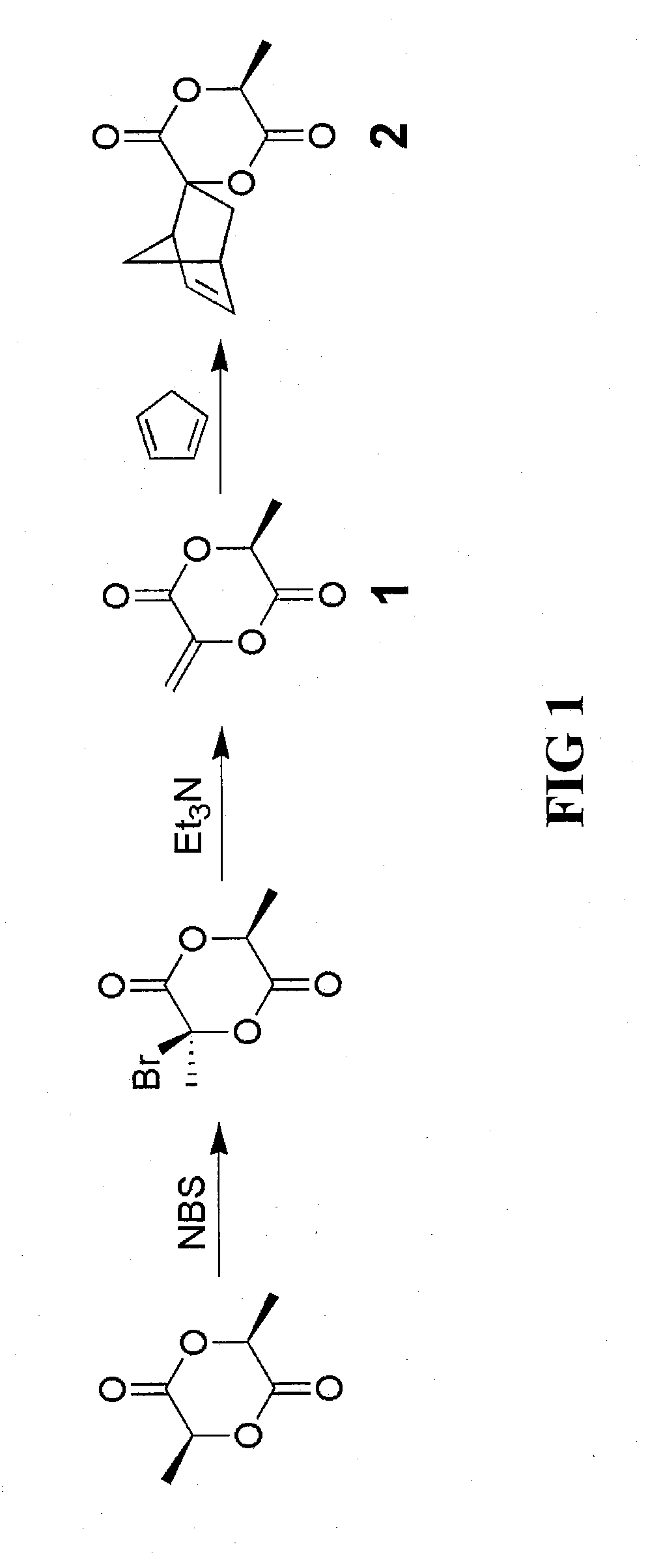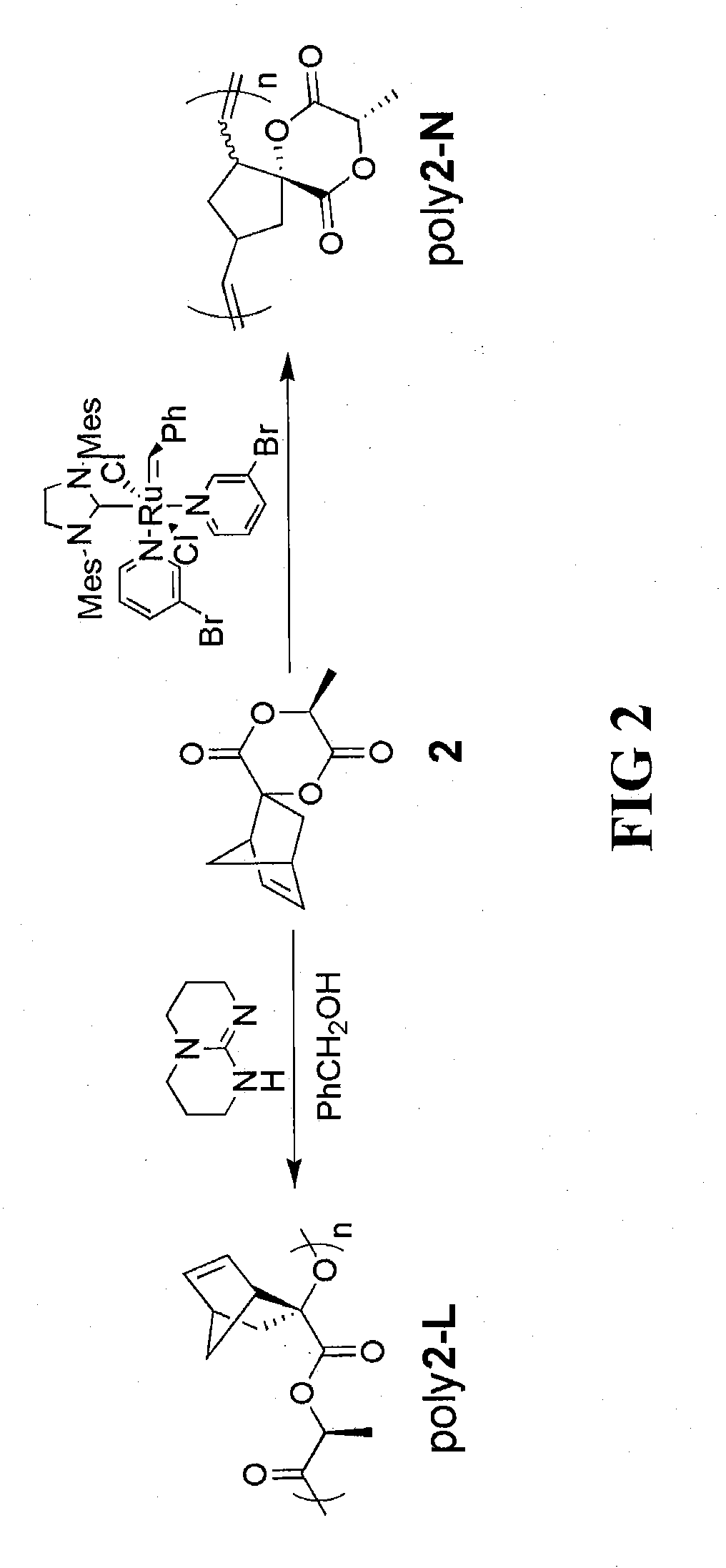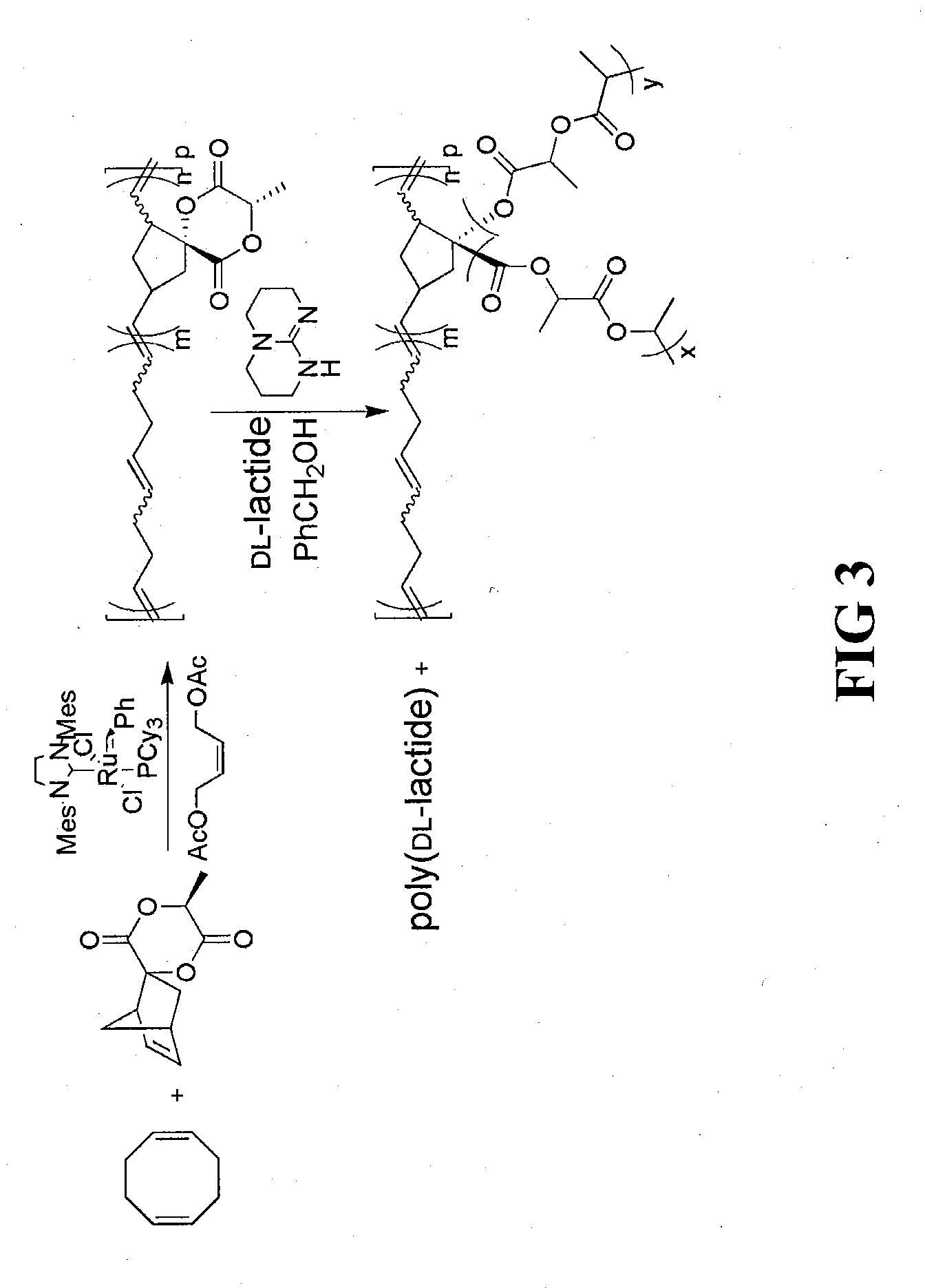Bifunctional lactide monomer derivative and polymers and materials prepared using the same
a technology of bifunctional lactide and monomer, which is applied in the field of bifunctional lactide monomer derivative and polymers and materials prepared using the same, can solve the problems of inability to balance the biodegradability of materials with durability and toughness, and the direct polymerization of lactic acid is not ideal for producing useful products, etc., and achieves enhanced and improved properties and chemical behaviors.
- Summary
- Abstract
- Description
- Claims
- Application Information
AI Technical Summary
Benefits of technology
Problems solved by technology
Method used
Image
Examples
example 1
Preparation of the Bifunctional Norbornene Spiro Lactide Monomer Derivative
[0036]The spiro[6-methyl-1,4-dioxane-2,5-dione-3,2′-bicyclo[2.2.1]hept[5]ene] monomer derivative of the invention can be prepared using the lactide compound (e.g., S,S-lactide (L-lactide), D-lactide or DL-lactide) as the starting material to prepare the intermediate compound 3-methyl-6-methylene-1,4-dioxane-2,5-dione. For this process, a bromine addition and elimination reaction on the lactide compound can be employed as illustrated in FIG. 1.
[0037]3-Bromo-3,6-dimethyl-1,4-dioxane-2,5-dione was prepared by adding L-lactide (200.0 g, 1.388 mol), benzene (1 L) and N-bromosuccimide (272.0 g, 1.528 mol) to a 2 L three-neck flask. The mixture was brought to a reflux under mechanical stirring. Benzoyl peroxide (6.72 g, 27.7 mmol) in benzene (100 mL) was then added dropwise through a dropping funnel over 20 minutes. After the monomer was consumed, the reaction mixture was cooled to room temperature, and the solid fi...
example 2
Preparation of Lactide Ring-Opened Polymer
[0046]A lactide-opened homopolymer poly(oxy-1-oxoethylene-2-bicyclo[2.2.1]hept-5-ene) can be prepared by ring opening polymerization (ROP) of the highly sterically hindered spiro[6-methyl-1,4-dioxane-2,5-dione-3,2′-bicyclo[2.2.1]hept[5]ene]. In a dry box, a catalyst / initiator solution was prepared by adding 1,5,7-triazabicyclo[4.4.0]dec-5-ene (TBD) (6.7 mg, 48 μmol), benzyl alcohol (10.0 μL, 96 μmol) and anhydrous CH2Cl2 (9.6 mL) to a 20 mL vial. To a 20 mL pressure vessel was added spiro[6-methyl-1,4-dioxane-2,5-dione-3,2′-bicyclo[2.2.1]hept[5]ene] (0.20 g, 0.96 mmol) and the catalyst / initiator solution (0.96 mL).
[0047]Variations of catalyst and initiator combinations are possible for this reaction step. For example, other strong bases that could possibly be used as the catalyst in place of TBD include 1,8-diazabicycloundec-7-ene (a.k.a. DBU) and N-methyl TBD. Primary alcohols can be used as the initiator in this process step as well, in pl...
example 3
Preparation of Norbornene Ring-Opened Polymer
[0055]To prepare the norbornene-opened homopolymer (poly(8-methyl-6,9-dioxa-spiro[4.5]decane-7,10-dione-1,3-diylvinylene)), spiro[6-methyl-1,4-dioxane-2,5-dione-3,2′-bicyclo[2.2.1]hept[5]ene]monomer derivative can be subjected to ring-opening metathesis polymerization (ROMP). Using this approach, spiro[6-methyl-1,4-dioxane-2,5-dione-3,2′-bicyclo[2.2.1]hept[5]ene] monomer (0.20 g, 0.96 mmol) and 3rd generation Grubbs' catalyst (8.5 mg, 9.6 μmol) (prepared using a process similar to that described in Grubbs, Angew. Chem., Int. Ed. 41, p. 4035-37 (2002)) were added to a 20 mL vial. The vial was fitted with a septum and purged under nitrogen for a period of 10 minutes. Dichloromethane (4.8 mL) was then added via syringe through the septum to the vial under quick stirring. After 30 minutes, the reaction was then quenched by addition of excess (>20 equivalents) of ethyl vinyl ether. The polymer solution was precipitated from methanol to remove ...
PUM
| Property | Measurement | Unit |
|---|---|---|
| tensile toughness | aaaaa | aaaaa |
| tensile strength at break | aaaaa | aaaaa |
| elongation break | aaaaa | aaaaa |
Abstract
Description
Claims
Application Information
 Login to View More
Login to View More - R&D
- Intellectual Property
- Life Sciences
- Materials
- Tech Scout
- Unparalleled Data Quality
- Higher Quality Content
- 60% Fewer Hallucinations
Browse by: Latest US Patents, China's latest patents, Technical Efficacy Thesaurus, Application Domain, Technology Topic, Popular Technical Reports.
© 2025 PatSnap. All rights reserved.Legal|Privacy policy|Modern Slavery Act Transparency Statement|Sitemap|About US| Contact US: help@patsnap.com



